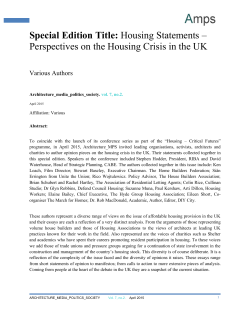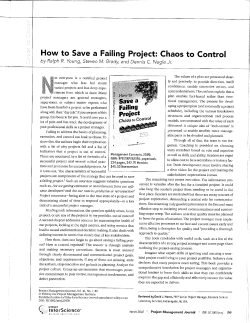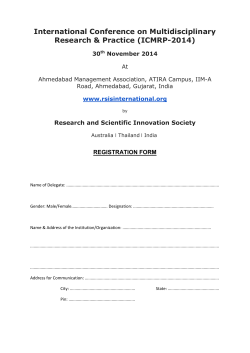
Rethinking Engineering Education: The CDIO Approach
Journal of Technology Education Vol. 26 No. 2, Spring 2015 Book Review Crawley, E., Malmqvist, J., Östlund, S., Brodeur, D., & Eström, K. (2014). Rethinking engineering education: The CDIO approach (2nd ed.). New York: Springer. ISBN: 978-3-319-05561-9 $139 (hardcover) 311 pages Undergraduate engineering students and industry hiring managers spent years awaiting a revolution in engineering education. That revolution seemingly arrived in 2007 with the first edition release of Rethinking Engineering Education: The CDIO Approach. In the second edition, Crawley, Malmqvist, Östlund, Brodeur, and Eström provide the engineering education community with an updated syllabus, standards, and an additional chapter to their original text. The authors attempt to address two main questions in their work: (a) “What is the full set of knowledge, skills, and attitudes that engineering students should possess as they leave the university, and at what level of proficiency?” (p. 17) and (b) “How can we do better at ensuring that students learn these skills?” (p. 20). Motivation and Overview The authors write primarily to engineering educators, administrators, and curriculum developers to discuss the Conceive-Design-Implement-Operate (CDIO) approach as it has now been implemented in classrooms across the globe. In looking at the gap between engineering education expectations and form, Crawley et al. (2014) “identified an underlying critical need—to educate students who are able to Conceive-Design-Implement-Operate complex, valueadded engineering products, processes and systems in a modern, team-based environment” (p. 1). Their message seems to be aimed at a wider audience that includes all engineering and technology educators. “It is not a matter of fixing something that is broken, but of improving something that is vital to our future, namely technological education” (p. 183). Education that is focused on preparing students with elements of practical knowledge must employ applied instruction. This theme is consistent throughout the text and the authors provide valuable insight on how to bring the applied element to classroom instruction. Crawley et al. (2014) make the case for their method by describing the role of engineers as conceiving devices and systems, designing “products, processes and systems that incorporate technology,” (p. 2) and implementing designs. They also suggest that engineers need to ensure devices and systems can be operated without issue. The authors describe the traditional education approach as not meeting the needs of students and industry employers to prepare graduates who are able to accomplish these aforementioned tasks. Simon Sultana (ssult004@odu.edu) is an Associate Professor at DeVry University and a graduate student in the Department of STEM Education at Old Dominion University. -74- Journal of Technology Education Vol. 26 No. 2, Spring 2015 Over the years, many graduates have found themselves working in environments bearing little, if any, resemblance to their educational experiences. The authors describe contextual learning and the importance of outside world examples to which students can relate new ideas. They explain how projects help students develop confidence to apply knowledge once they begin working. Their message has certainly been heard as they boast over one hundred institutions of higher learning around the world using these methods (Crawley et al., 2014). This text is required reading for engineering and technology educators or administrators. After establishing the motivation for the approach, the authors clearly define CDIO and present its syllabus and desired learning outcomes. They then discuss the role of integrated curriculum and the importance of designimplement experiences. Here, the authors also offer ideas related to adaptable workspaces that promote hands-on learning and collaboration. Next, they cover teaching, learning, and assessment in the CDIO format and provide direction on implementation. Crawley et al. cover program evaluation before providing a brief history of the development of engineering education. They conclude the text with a new chapter on the future of the CDIO approach. The twelve CDIO standards (Table 1) are presented in order throughout the book’s eleven chapters, and are supplemented with vignettes that include examples of functional elements. The text includes the updated CDIO syllabus, which incorporates the new topics of leadership and entrepreneurship, and the standards and rubrics in appendices. CDIO as a Context Crawley et al. indicate their tasks have been chosen because they apply to all types of engineering disciplines and activities and have been consistently used throughout the past five decades. The context of engineering has involved a focus on society’s problems, the products, processes, and systems to address those problems, invention and technology, collaboration with other disciplines, the need for effective communication, and dealing with resource constraints. The authors explain the system lifecycle as providing the appropriate context in which to teach engineering curriculum. They make it clear this approach provides the context, not the content, of teaching engineering. There is no “dumbing down” of the engineering disciplines. Crawley et al. (2014) posit engineering content should be taught in this framework because “(a) it is what engineers do; (b) it is the basis for the desirable skills that industry proposes to university educators; (c) it is the natural context in which to teach these skills; and, (d) it better supports the learning of the technical fundamentals” (p. 32). Engineering students are often disappointed that these facets of the discipline are not covered in their educational experiences. These situations often shape student persistence in engineering -75- Journal of Technology Education Vol. 26 No. 2, Spring 2015 programs, so administrators and educators concerned with this area should take note. Important components in the approach are design-implement experiences. Students need to be able to design and implement ideas because these activities are central to what engineers do. Crawley et al. recommend students be given opportunities early on and throughout their programs to develop these skills. They argue content should be learned in the context of design-implement experience involving active learning. The authors also discuss the importance of reflection on the part of students. Students must be given the time to think about their designs, how they have implemented them, and pose questions about potential improvements. Engineering students who have developed strong habits of continuous improvement will be the most successful. Meeting Challenges to Implementation Those convinced of the potential of the CDIO approach will most certainly face significant challenges in implementing these methodologies. Crawley et al. (2014) explain that implementation “implies a shift in the nature of engineering education to a more integrated curriculum” (p. 37). The past two decades have been replete with research focused on integrated approaches in engineering classrooms (Craft & Mack, 2001; Grigg et al., 2004; Jenkins, Pocock, Meade, Mitchell, & Farrington, 2002). There has been emphasis on implementing an increased practical element to what had previously been centered on science and theory. Those hoping to redefine engineering education have been focused on the challenges that present themselves, and how best to deal with them. In Redefining Engineering Education, the authors prepare their readers and provide answers. The authors dedicate a chapter to the topic of effecting change and dealing with how to properly get started in this endeavor through implementing the core activities and institutionalizing change. They give their readers numerous recommendations on how to go about the process of change. First, they recommend teams be comprised of established leaders and newer faculty members; this approach is necessary to avoid the “us and them” mentality. Second, the writers state change agents must work outside of traditional assumptions; curriculum designers don’t change because of long standing usage. They encourage the field to move past this thinking and involve all stakeholders, including students, in the process. The authors point out the importance of recognizing faculty who are instrumental in executing the new approach and providing incentives. They stress creating a “culture of faculty learning” (p. 194) and recommend providing opportunities for development, specifically involving both professional activities and scholarly work; this emphasis on both facets is important for those looking to include both in their classrooms. Finally, Crawley et al. explain both students’ formal academic requirements and informal expectations, and thus provide a -76- Journal of Technology Education Vol. 26 No. 2, Spring 2015 clear message to students about their academic goals and how they will be actively involved in their own learning. There are important suggestions throughout this section for educators of all engineering disciplines and even those outside engineering education. Version Updates For those readers familiar with the original release of the CDIO syllabus, the authors explain the reason for this updated version arising from new knowledge and missing information identified by users. This update clarifies the organization of the approach by better outlining its structure. The authors made a concerted effort to revise content based on international accreditation and curriculum evaluation texts. They discuss the internationalization of engineering education and this inclusive list of accrediting bodies ensures the adaptability of the syllabus to this trend. Crawley et al. have also included missing items identified by users of the previous syllabus and clarified terminology. The updated release is more complete since the authors have incorporated feedback from a vast number of users from all over the globe. We are reminded the syllabus is not meant to dictate every facet of curriculum design, but serves as a tool that can be adapted as necessary. Concluding Remarks Crawley et al. (2014) have developed an important resource for engineering educators and curriculum developers. There are elements that are important for all engineering and technology educators, and also teachers in any discipline looking to incorporate increased practical elements into their classrooms. This review has focused on specific topics including the motivation to transform engineering curriculum and overcoming the barriers to implementing that change. It is hoped readers are compelled to think about the need for changing engineering education and realize they can overcome the obstacles by becoming change agents and heed the call for improvement. We owe it to our stakeholders to provide an education that prepares students for their world of work and meets the needs of industry and society. The authors of Rethinking Engineering Education compel us to change and provide us with the resources we need to get there. -77- Journal of Technology Education Vol. 26 No. 2, Spring 2015 Table 1 The CDIO Standards v2.0 Standard 1 – The Content 2 – Learning Outcomes 3 – Integrated Curriculum 4 – Introduction to Engineering 5 – Design-Implement Experiences 6 – Engineering Workspaces 7 – Integrated Learning Experiences 8 – Active Learning 9 – Enhancement of Faculty Competence Adoption of the principle that product, process, and system lifecycle development and deployment—Conceiving, Designing, Implementing and Operating—are the context for engineering education Specific, detailed learning outcomes for personal and interpersonal skills, and product, process, and system building skills, as well as disciplinary knowledge, consistent with program goals and validated by program stakeholders A curriculum designed with mutually supporting disciplinary courses, with an explicit plan to integrate personal and interpersonal skills, and product, process, and system building skills An introductory course that provides the framework for engineering practice in product, process, and system building, and introduces essential personal and interpersonal skills A curriculum that includes two or more designimplement experiences, including one at a basic level and one at an advanced level Engineering workspaces and laboratories that support and encourage hands-on learning of product, process, and system building, disciplinary knowledge, and social learning Integrated learning experiences that lead to the acquisition of disciplinary knowledge, as well as personal and interpersonal skills, and product, process, and system building skills Teaching and learning based on active experiential learning methods Actions that enhance faculty competence in personal and interpersonal skills, and product, process, and system building skills -78- Journal of Technology Education Vol. 26 No. 2, Spring 2015 10 – Enhancement of Faculty Actions that enhance faculty competence in Teaching Competence providing integrated learning experiences, in using active experiential learning methods, and in assessing student learning 11 – Learning Assessment Assessment of student learning in personal and interpersonal skills, and product, process, and system building skills, as well as in disciplinary knowledge 12 – Program Evaluation A system that evaluates programs against these twelve standards, and provides feedback to students, faculty, and other stakeholders for the purposes of continuous improvement References Craft, E., & Mack, L. (2001). Developing and implementing an integrated, problem-based engineering technology curriculum in an American technical college system. Community College Journal of Research & Practice, 25(56), 425-439. Grigg, N., Criswell, M., Fontane, D., Saito, L., Siller, T., & Sunada, D. (2013). Integrated civil engineering curriculum: Five-year review. Journal of Professional Issues in Engineering Education & Practice, 130(3), 160-165. Jenkins, S., Pocock, J., Meade, R., Mitchell, Z., & Farrington, J. (2002). Capstone course in an integrated engineering curriculum. Journal of Professional Issues in Engineering Education & Practice, 128(2), 75-82. -79-
© Copyright 2025









